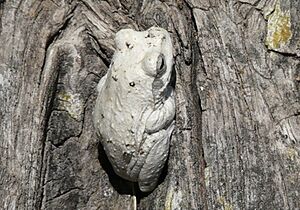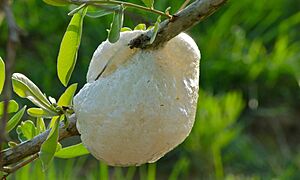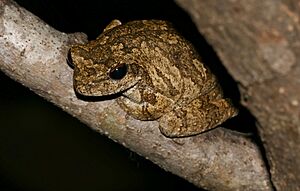Grey foam-nest tree frog facts for kids
Quick facts for kids Grey foam-nest tree frog |
|
|---|---|
 |
|
| Conservation status | |
| Scientific classification |
The grey foam-nest tree frog (Chiromantis xerampelina) is also called the southern foam-nest tree frog. This amazing frog belongs to the Rhacophoridae family. You can find these frogs living in southern Africa.
These frogs are special because of how they lay their eggs. The female frog makes a foamy nest, usually on tree branches hanging over water. This foam keeps the eggs safe and moist as they grow. This unique way of nesting is how they got their name!
Contents
About the Grey Foam-Nest Tree Frog
Grey foam-nest tree frogs spend most of their lives in trees. They have special discs on their toes that help them climb. Their outer two fingers are spread wide apart, almost at a right angle to their other fingers. This helps them grip branches.
These frogs can grow to different sizes. Male frogs are usually between 43 and 75 millimeters long. Female frogs are a bit bigger, measuring 60 to 90 millimeters long. Their skin is a bit bumpy and dry. It can change color from white to brown, depending on the temperature.
Where They Live
Grey foam-nest tree frogs live in many different places. You can find them in savannas, shrublands, forests, and even in gardens or city areas. They are known as "habitat specialists." This means they prefer to breed only in quiet, untouched natural places.
These frogs do not like very dry weather. They need humidity to survive. However, they can still live in dry forests or cultivated areas at low altitudes. They can survive dry seasons by hiding under loose tree bark. This is why they are called tree frogs! Big rainstorms make more frogs breed. This is because high humidity helps their eggs survive and grow.
How They Live
Reproduction and Life Cycle
Grey foam-nest tree frogs usually mate at night. This happens from October to February during the wet summer months in southeastern Africa. They choose to mate in trees, building their foam nests on branches above water.
The female frog starts the nesting process. She makes a thick, sticky fluid from her body. She then uses her back legs to whip this fluid into a foamy, elastic nest. This foam will protect the developing eggs. The female might leave for a short time to get more water, then she comes back. Building the nest can take about five to six hours.
After the female lays her eggs, the male frogs add their sperm to the foam. This fertilizes the eggs. The next day, the female returns to add another layer of foam. This extra layer helps protect the eggs from drying out.
The foam nest is very important for the eggs. If the frogs breed in water, the foam helps the eggs float in water with plenty of oxygen. If they breed on land, the nests keep the eggs from drying out. They also protect them from big temperature changes and from predators.
A female frog can lay between 500 and 1250 eggs at one time. They carefully hang their foam nests on tree branches above water. Having many male mates can help more eggs get fertilized and survive.
The eggs develop inside the foam nest for about six days. The mother frog makes sure the eggs stay moist the day after mating. After the eggs develop, a tiny tadpole breaks free from the foam. It then drops into the water below the nest. Tadpoles live at the bottom of the water. They become adult frogs in about six to eight weeks.
Frog Adaptations
These frogs often live in dry or partly dry places. They have developed several special ways to survive for months without much water.
- Waterproof Skin: Their skin is very good at holding water in. It's almost as good as a reptile's skin! This is why they are sometimes called "waterproof frogs." However, the skin on their belly is not as resistant. When it's dry, they tuck their bellies under them to protect that skin.
- Color Change: They can change their skin color from chalky white to dark brown. The brown color often looks like tree bark. They change color to control their body temperature. When they are dark, they warm up faster in the sun. This helps them when it's cooler than 36°C. When they are white, they reflect heat away. This helps them stay cool when it's hot.
- Water Conservation: These frogs can lose up to 60% of their body weight in water over several months and still survive. They also get rid of waste in a special way. They produce uric acid, which is a solid, so they don't lose water when they get rid of it. This is very helpful in dry places.
- Sealing Gaps: When they hide during dry periods, they can make a water-resistant mucus. This mucus helps seal any small gaps around them. This keeps them from losing water.
Threats to the Frogs
Other animals can be a danger to grey foam-nest tree frogs. For example, a type of frog called Afrixalus fornasinii is known to eat their eggs and tadpoles.
See also
- Chiromantis petersii
- African foam-nest tree frog
- Chiromantis kelleri




